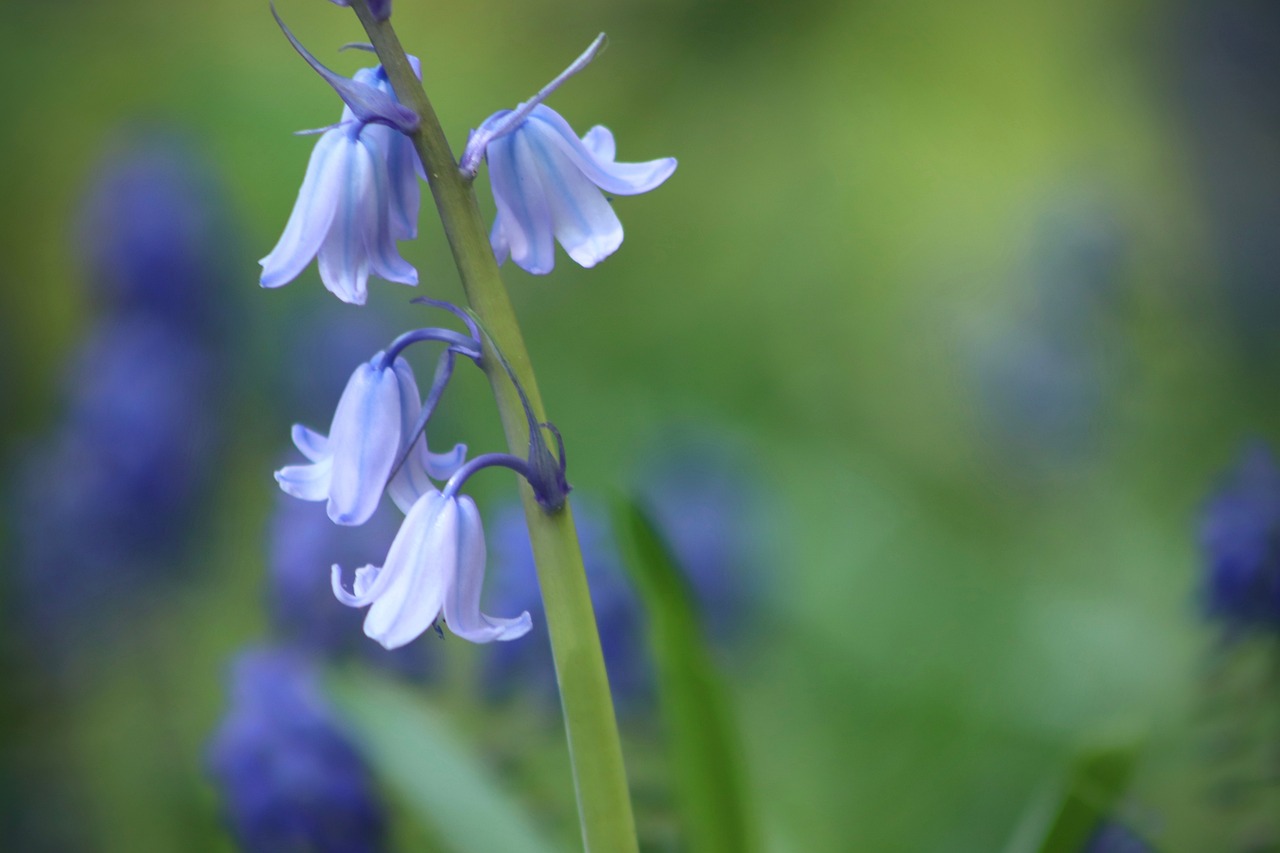In the quiet corners of woodlands and meadows, where sunlight filters through the leaves and birdsong fills the air, a carpet of delicate bluebells emerges each spring. These enchanting blossoms, with their nodding heads and vibrant hues, carry a mystique that has captivated nature lovers for centuries. In this blog post, we embark on a journey to unravel the secrets of the bluebell, exploring the folklore, symbolism, and natural beauty that make this flower a symbol of enchantment.
The Bluebell’s Botanical Ballet:
Before delving into the mystique, let’s appreciate the bluebell’s botanical elegance. The scientific name for the common bluebell is Hyacinthoides non-scripta, and it belongs to the Asparagaceae family. Native to Western Europe, these perennial bulbs typically bloom in late spring, gracing woodlands and shaded areas with their presence.
Physical Characteristics: Bluebells are characterized by their slender stems, arching leaves, and distinctive bell-shaped flowers. The nodding, pendulous blooms dangle delicately, forming clusters that create a sea of blue beneath the forest canopy. The petals often exhibit a gentle curl, giving the blossoms an almost ethereal quality.
Color Variations: While the name suggests a uniform blue hue, bluebells can display variations in color, ranging from pale lavender to deep violet-blue. The flowers’ coloring is complemented by narrow, linear leaves that contribute to the plant’s overall grace.
Folklore and Legends:
The bluebell has been intertwined with folklore and legends, adding an extra layer of fascination to its already charming presence. One prevalent myth suggests that bluebells are fairy flowers, believed to ring in the presence of fairies or magical beings. Legend has it that anyone who hears the tinkling sound of bluebell bells risks being spirited away to the fairy realm.
Another tale associates bluebells with the woodlands’ enchanting spirits. It’s said that the bluebell’s nodding head signifies its respect for passing fairies, bowing in acknowledgment of their ethereal presence.
Symbolism and Significance:
Beyond folklore, the bluebell carries symbolic meanings that add depth to its allure. Here are some interpretations associated with this enchanting blossom:
- Humility and Gratitude: The bluebell’s bowing head is often interpreted as a symbol of humility and gratitude. In cultures that ascribe human-like characteristics to plants, the bluebell’s posture is seen as a gesture of respect and acknowledgment.
- Constancy and Everlasting Love: In the language of flowers, bluebells are sometimes associated with constancy and everlasting love. The enduring beauty of these blossoms, returning year after year in the same woodland spaces, evokes sentiments of enduring affection.
- Rebirth and Renewal: As a spring flower, the bluebell is also linked to themes of rebirth and renewal. Its emergence from the forest floor signals the end of winter’s dormancy, bringing with it a burst of color and life.
- Protection and Warding off Evil: In some traditions, bluebells are thought to possess protective qualities. It’s believed that planting bluebells around the home or wearing them as a charm can ward off evil spirits.
Conservation Concerns:
Despite their magical charm, bluebells face conservation challenges. The native English bluebell (Hyacinthoides non-scripta) is threatened by the invasive Spanish bluebell (Hyacinthoides hispanica) in some areas. Crossbreeding between the two species can result in hybrids that dilute the purity of the native bluebell population.
Conservation efforts aim to protect and preserve native bluebell populations, emphasizing the importance of enjoying these flowers in their natural habitats and avoiding picking or disturbing them.
Cultural Connections:
Bluebells have found their way into various aspects of human culture, from literature and art to festivals and celebrations. In literature, these blossoms are often featured as symbols of beauty and enchantment. Notable works, such as Anne Brontë’s “The Bluebell,” capture the flower’s poetic essence.
In art, bluebells are a popular subject, celebrated for their delicate and evocative form. Paintings and illustrations featuring bluebells evoke a sense of tranquility and natural beauty.

Caring for Bluebells:
For those lucky enough to have bluebells gracing their gardens, caring for these enchanting blooms involves understanding their natural habitat. Bluebells thrive in shaded, woodland-like settings with well-drained soil. Here are some tips for cultivating and preserving bluebells:
- Planting Depth: When planting bluebell bulbs, ensure they are buried at a depth of around three times their size. This ensures proper insulation and protection during colder months.
- Naturalizing: Bluebells have a charming way of naturalizing – spreading and multiplying on their own. Allow them to establish their own rhythm, and you’ll be rewarded with a carpet of blossoms in the years to come.
- Avoid Disturbing Wild Populations: If you encounter bluebells in the wild, refrain from picking or digging up the bulbs. Disturbing natural populations can impact their ability to thrive and spread.
- Invasive Species Awareness: Be mindful of the potential presence of invasive Spanish bluebells. If introducing bluebells to your garden, ensure they are of the native English variety to protect the genetic purity of wild populations.
The secrets of the bluebell lie not only in its physical beauty but also in the rich tapestry of folklore, symbolism, and cultural connections that surround it. As you encounter these enchanting blossoms in woodland glades or cultivated gardens, take a moment to appreciate the mystique and magic they bring to the natural world. The bluebell, with its nodding head and vibrant hues, invites us to connect with nature’s wonders and embrace the timeless allure of this captivating springtime flower.



